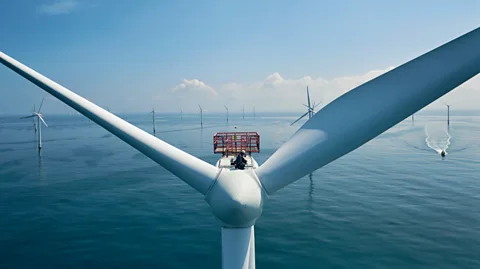How bubble curtains protect porpoises from wind farm noise
 Hydrotechnik Lübeck
Hydrotechnik LübeckAs huge offshore wind farms spread across Europe's North and Baltic seas, efforts grow to buffer the impact on wildlife.
Over the past decade, a curious invention has spread across Europe's northern seas. It's called a big bubble curtain, it works a bit like a giant jacuzzi, and it helps protect porpoises from the massive underwater noise caused by wind farm construction.
A very large, perforated hose is laid on the seabed, encircling the wind turbine site. Air is pumped through, and bubbles rise from the holes to the surface of the water, forming a noise-buffering veil.
The quirky gadget, also known as a big bubble veil, was pioneered in to help protect the endangered harbour porpoise, the only cetacean species living in its North Sea and Baltic Sea. The bubble curtain was designed around the porpoise's specific needs and traits, lowering wind farm construction noise to a threshold deemed safe for the species, based on scientific research. Its proven muffling effect may also benefit other marine mammals that are vulnerable to noise, such as seals.
The bubble curtain is now widely used by northern European countries racing to build more offshore wind farms as part of their efforts to curb CO2 emissions and fight global warming. Countries including the Netherlands, , Denmark and Belgium have pledged to turn the North Sea into "the world's largest green power plant", aiming to tly increase their offshore wind capacity there to 300GW by 2050. At the same time, they are under pressure to reduce the potential impact of wind farm construction noise on marine creatures, for whom sound is everything.
 Alamy
Alamy"Pretty much every creature in the sea relies on underwater sound. On land, most animals tend to use vision as their main sense, but in the underwater world, it's hearing," says Carina Juretzek, a specialist in underwater noise at 's Federal Maritime and Hydrographic Agency, which regulates and approves offshore wind farms.
The small, round harbour porpoise is very sensitive to sound. It uses echolocation to navigate, communicate, hunt and avoid obstacles in often dark or murky waters, emitting ultrasonic clicks that bounce off fish or objects. Loud, human-made underwater noise – including from shipping and offshore wind farm construction – can disturb and disorient the porpoise.
Bubble curtains are based on a simple principle: sound travels faster through water than through air, because water and air have different densities. When sound waves hit the bubble curtain, they slow down, break up, and bounce against the bubbles, resulting in a loss of energy. The remaining sound that emerges on the other side of the curtain is therefore quieter.
In the North Sea, the number of wind turbines has risen from only 80 in 2002, to more than 4,000 today – and many more are planned as part of the green energy revolution. Spinning in fierce, fast sea winds, offshore turbines can produce more energy than those on land. On average, an onshore wind turbine generates around 2.5 to 3 megawatts (MW), whereas the average offshore turbine produces 3.6 MW. The scale of the latest offshore models is staggering, with heights of more than 270 metres (890ft), and each blade measuring more than 100 metres (330ft), about the length of a football pitch. A single turbine can generate enough power for a small town of 18,000 households every year. Construction of the Dogger Bank Wind Farm, a development off the coast of England, involved a ship that's as tall as the Eiffel Tower.
As one might expect, installing these giants at sea comes with a lot of noise.
Even before the building begins, the seabed may have to be cleared of toxic World War Two bombs or mines – which happens via controlled explosions. Next, a long steel foundation, called a pile, is driven deep into the seabed with several thousand hydraulic hammer blows. This foundation then s the turbine. The process is called pile-driving, and its sound is a source of concern to regulators and scientists who monitor the wellbeing of porpoises.
"Pile-driving noise really is one of the more intense human-made noises we can inflict on the environment," says Juretzek. "There's scientific evidence that this kind of noise would affect the marine environment, if it's not reduced in some way. And that's why has decided that this pile-driving noise has to be lowered through various technical steps."
 Vattenfall
Vattenfall